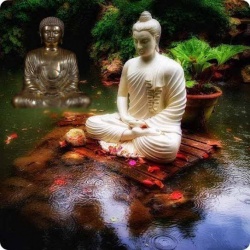Life Span of the Thus Come One
"Life Span of the Thus Come One" chapter
如来寿量品 (Jpn Nyorai-juryo-hon )
Abbreviated as the "Life Span" chapter. The sixteenth chapter of the Lotus Sutra, in which Shakyamuni Buddha reveals that he originally attained enlightenment in the far distant past rather than in his present life in India as his listeners generally thought. The chapter title "The Life Span of the Thus Come One" means the duration of Shakyamuni's life as a Buddha, that is, how much time has passed since he originally attained Buddhahood. T'ient'ai (538-597) of China ranks it as the key chapter of the essential teaching, or the latter fourteen chapters of the sutra. The chapter opens with three exhortations and four entreaties, in which the Buddha three times admonishes the multitude to believe and understand his truthful words, and the assembly four times begs him to preach. Shakyamuni then says, "You must listen carefully and hear of the Thus Come One's secret and his transcendental powers." He proceeds to explain that, while all heavenly and human beings and asuras believe that he first attained enlightenment in his present lifetime under the bodhi tree, it has actually been an incalculable length of time since he attained enlightenment.
He then offers a dramatic description of the magnitude of this immeasurably long period. He describes taking a vast number of worlds, grinding them to dust, and then traversing the universe, dropping a particle each time one passes an equally vast number of worlds. Having exhausted all the dust particles, one takes all the worlds traversed, whether they have received a dust particle or not, and grinds them to dust. Then Shakyamuni says: "Let one particle represent one kalpa. The time that has passed since I attained Buddhahood surpasses this by a hundred, a thousand, ten thousand, a million nayuta asamkhya kalpas." Commentaries on this chapter refer to this cosmically immense period as "numberless major world system dust particle kalpas." In the essential teaching of the Lotus Sutra, Shakyamuni thus refutes the view that he attained enlightenment for the first time in this life in India and reveals his original attainment of enlightenment in the remote past. T'ient'ai refers to this in The Words and Phrases of the Lotus Sutra and The Profound Meaning of the Lotus Sutra as "opening the near and revealing the distant," "casting off the transient and revealing the true," and "opening the transient and revealing the true."
Here, "the transient" means Shakyamuni's transient status, and "the true" means his true identity. From his original attainment of Buddhahood, Shakyamuni declares, he has constantly been here in this saha world preaching the Law, appearing as many different Buddhas and using various means to save living beings. Though he says that he enters nirvana, he merely uses his death as a means to arouse in people the desire to seek a Buddha. He then illustrates this idea with the parable of the skilled physician and his sick children. In the parable, the children of a skilled physician have accidentally swallowed poison. Having lost their senses, they refuse the medicine their father offers them as an antidote. The father then goes off to a remote place and sends a message informing his children he has died. Shocked to their senses, the children take the medicine their father has left for them and are cured. The Buddha is compared to the father in this parable, living beings to the children who have drunk poison, and the Buddha's entry into nirvana to the father's report of his own death—an expedient means to arouse in people the aspiration for enlightenment.The chapter concludes with a verse section, which restates the important teachings of the preceding prose section.
In Profound Meaning, T'ient'ai interprets the "Life Span" chapter as revealing the three mystic principles of the true cause (the cause for Shakyamuni's original attainment of enlightenment), the true effect (his original enlightenment), and the true land (the place where the Buddha lives and teaches). He interprets the passage "Originally I practiced the bodhisattva way... " as indicating the stage of nonregression, or the eleventh of the fifty-two stages of bodhisattva practice, which he explained as the true cause that enabled Shakyamuni to attain Buddhahood. In answer to the question of what Shakyamuni practiced in order to reach the stage of non-regression, Nichiren (1222-1282) identified it as the Law of Nam-myoho-renge-kyo.
